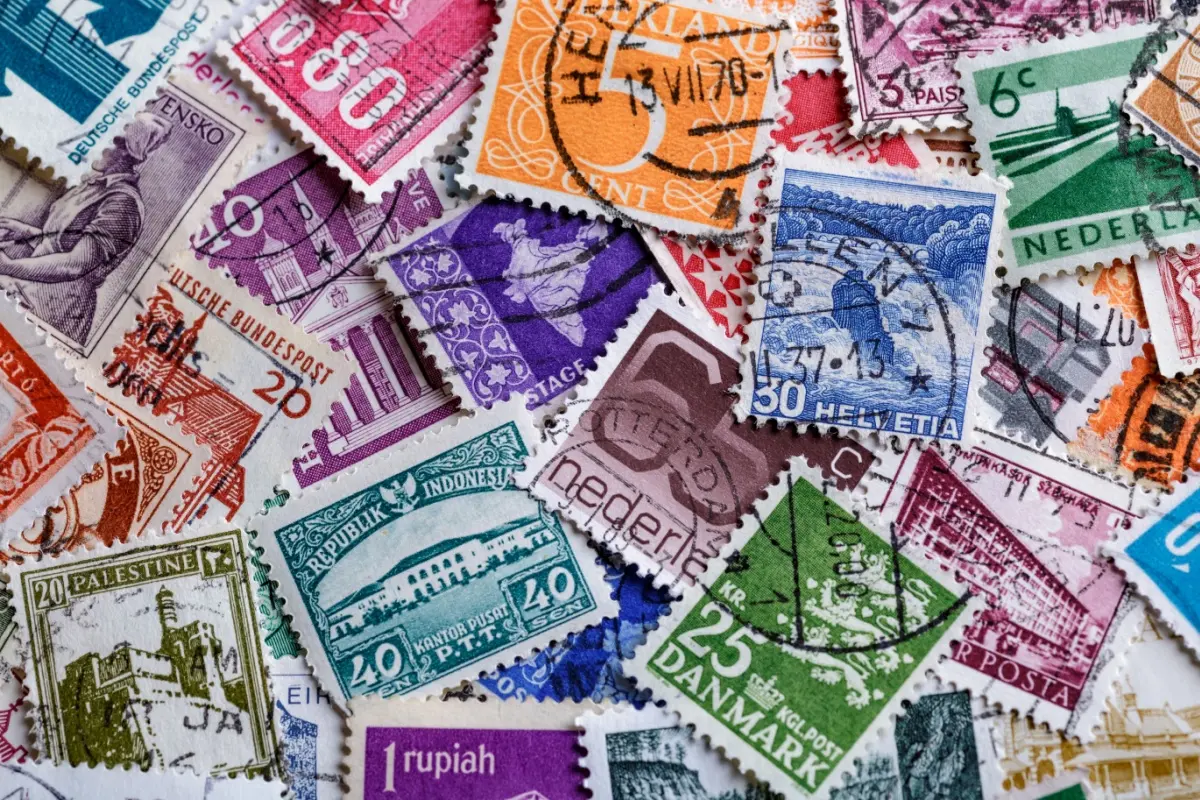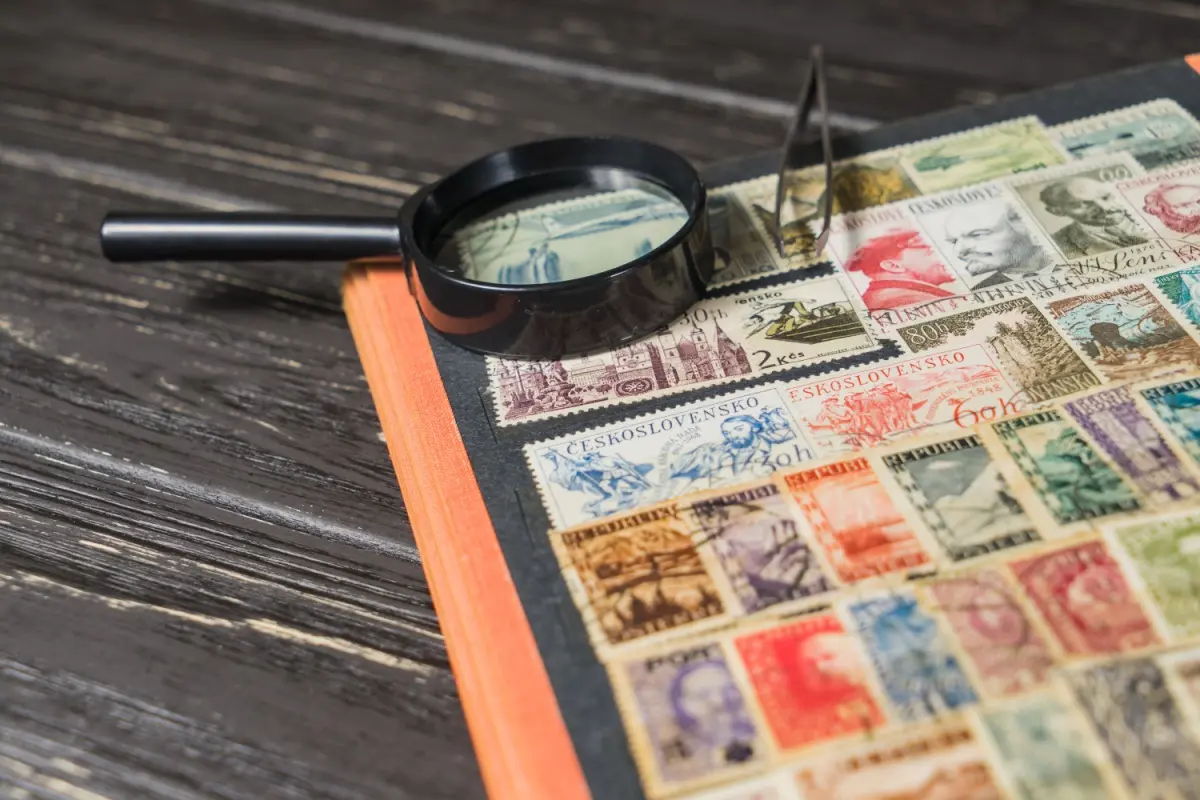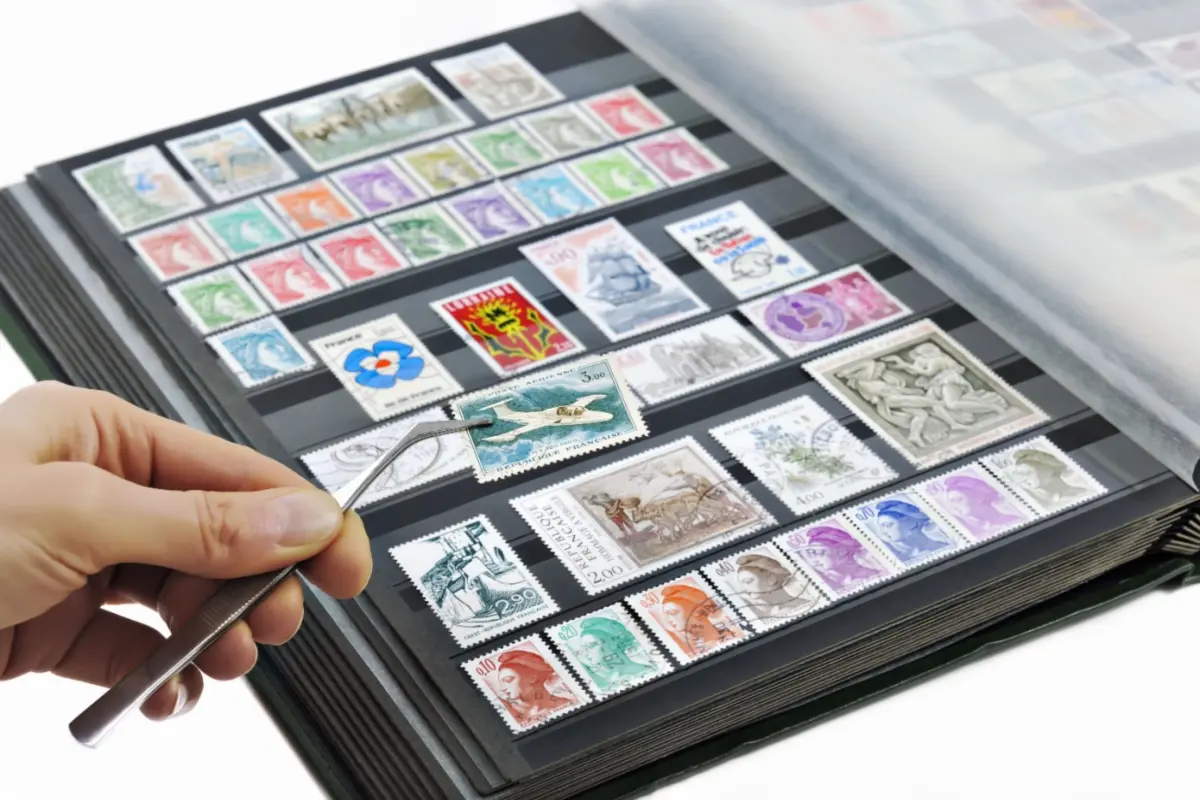How to Start Collecting Stamps: Comprehensive Beginners Guide
Something is captivating about stamps — their designs, history, and the stories they carry from far-off places. Starting a stamp collection is about finding those little pieces of history that mean something to you, whether it’s a rare edition or a beautifully designed stamp from another era.
In this guide, you’ll learn everything to begin building your collection.
Understanding Stamp Collecting
Philately, studying stamps and postal history is a hobby that bridges history, culture, and art. Let’s delve into the roots of this exciting hobby and understand why it remains a cherished activity for around 180 years.
History of Stamp Collecting
The origins of stamp collecting trace back to the introduction of the first adhesive postage stamp, the Penny Black, issued in Britain in 1840.

This small stamp, featuring a profile of Queen Victoria, revolutionized communication by creating a more affordable way for people to send letters. Soon, stamps spread across Europe and beyond, each country producing its designs, symbols, and values.
As more people started to use stamps for correspondence, the idea of collecting them began to take hold.
By the 1860s, saving and exchanging stamps was so popular that it led to the first stamp catalog publication. It also led to clubs dedicated to philately. These clubs offered collectors a platform to share their passion, showcase prized pieces, and exchange information on new issues and rare finds. For instance, notable societies, such as the Royal Philatelic Society of London, were key in promoting stamp collecting and organizing events.
Stamp exhibitions also became common and attracted audiences from all around the world. They helped create an international stamp-collecting culture where enthusiasts and dealers could gather to buy, trade, and display rare and unique stamps.
Today, stamp collection continues to be a thriving hobby. Some collectors focus on historical stamps from specific countries, while others pursue thematic collections. Some of the most common themes are wildlife, space exploration, and famous figures.
Why Start Stamp Collecting?
Collecting stamps allows you to journey into the world’s history, art, and culture, all captured in miniature. Each stamp represents a unique aspect of its country of origin, commemorating historical events, honoring notable figures, or showcasing native landscapes and wildlife.
Beyond cultural appreciation, stamp collecting appeals to those who enjoy details and precision. Some stamps are prized for their intricate designs and craftsmanship, while others hold value due to their rarity and historical significance.
Investing in rare stamps can be a rewarding pursuit. While it won’t earn you residual income, some collections may increase in value over time. Plus, a collection can become cherished family heirlooms.
Collecting stamps has personal benefits. Many find the process of sorting, organizing, and researching stamps to be a calming, meditative experience.
Plus, the stamp-collecting community is global, and connecting with other enthusiasts, whether through local clubs, online forums, or international events, has become an enjoyable part of the hobby.
Types of Stamps to Collect
As a beginner, exploring different types of stamps can help you decide which areas interest you the most. Here are some of the most popular types of stamps you should know about:
Commemorative Stamps
Commemorative stamps mark critical historical events, notable figures, anniversaries, or cultural milestones. These stamps are produced in limited quantities, and that’s what makes them so popular among collectors.
One notable example is the U.S. “Moon Landing” stamp, issued in 1969, which celebrates the Apollo 11 mission and features Neil Armstrong on the moon.
Another famous commemorative stamp is the UK’s “Silver Jubilee” stamp from 1935, which honored King George V’s 25th year on the throne.
Definitive Stamps
Definitive stamps are used for everyday mail and are printed in large quantities. They often feature simpler designs of national symbols or leaders.
The UK’s “Machin” series, portraying Queen Elizabeth II since 1967, is a classic example of definitive stamps as it has been printed over 200 billion times.
Airmail Stamps
As the name suggests, airmail stamps are explicitly created for airmail and often include themes related to aviation and travel.
One of the most famous airmail stamps is the U.S. “Inverted Jenny” from 1918, which mistakenly printed an airplane upside down, making it very valuable. A well-preserved Inverted Jenny sold for $2 million in November 2023.
The French “Aeropostale” series is well known and sought after. It celebrates the early air routes that connected France with South America.
Revenue Stamps
Unlike postage stamps, revenue stamps collected taxes or fees on documents, goods, or services. They carry a unique historical value.
Noteworthy revenue stamps include the British “Embossed Revenue” stamps used in the 1800s on legal documents and India’s “Court Fee” stamps, which were required for judicial documents.
Souvenir Sheets
Souvenir sheets feature one or more stamps to commemorate special events and anniversaries. The stamps are still attached to the sheet on which they were printed.
The entire sheet is designed with images or information related to the stamp’s theme, creating a collectible piece.
One famous example is the 2009 “Kew Gardens” souvenir sheet issued by the UK’s Royal Mail. This sheet commemorated the 250th anniversary of the Royal Botanical Gardens, Kew. It features stamps of rare plants found in the gardens and detailed backgrounds of the gardens themselves.
Postage Due Stamps
Postage-due stamps were used when mail was sent without sufficient postage, and the recipient was required to pay the difference.
They indicated the amount owed with big, bold numbers printed to clarify the charge.
For instance, the U.S. introduced a “Postage Due” series in 1879. The series featured distinct red numbers on a plain background to highlight the unpaid amount quickly.
Local Stamps
Local stamps are issued by regional authorities rather than a national postal service. They were often created for remote locations or islands with limited national mail services.
One of the most well-known local stamps by collectors is the Lundy Island stamps from the UK. In 1929, Lundy Island issued its stamps featuring wildlife and cultural symbols like a puffin. People used them to pay for local mail carried between Lundy and the mainland, valid only on the island.
Stamp Collecting Equipment
Building a stamp collection isn’t just about collecting stamps; you need to know how to properly handle, display, and preserve them to maintain their condition and value over time. As you gather these tools, consider your budgeting methods to manage your expenses effectively.
Here are some stamp-collecting supplies to consider:
Stamp Album
You need an album to store and organize your collection. They are available in various styles. For example, there are pre-printed albums with designated spaces for each stamp or blank albums that give you the flexibility to arrange stamps however you want.

When choosing the style you want, just pick one with acid-free paper. This protects your stamps from yellowing over time.
Stamp Tongs
These tweezers are specially designed to pick up delicate objects like stamps. They have smooth, rounded tips that prevent damage when handling.
Using tongs also keeps oils from your fingers off the stamps. This reduces the risk of staining or tearing, helping you maintain your stamps’ condition and value.
Watermark Detector
Watermarks are faint designs embedded into the paper during the manufacturing process. They were more commonly used in the late 19th and early 20th centuries as a security feature to prevent counterfeiting.
Using a watermark detector makes these marks more straightforward to see. It also allows collectors to identify unique watermarks, revealing a stamp’s rarity easily.
Magnifying Glass
A magnifying glass is necessary to inspect small details invisible to the naked eye. These can be intricate designs, tiny text, or even flaws.
Collectors often use it to examine watermarks, check printing quality, or identify subtle differences between similar stamps.
Perforation Gauge
Some stamps with identical designs differ only by perforations, which are the small holes along the edges. To help identify specific editions and variations accurately, you need a perforation gauge to measure the exact spacing and distinguish them.
An example is the U.S. “Washington-Franklin” series issued from 1908 to 1922. It features images of George Washington and Benjamin Franklin with nearly identical designs. Although these stamps look the same at first glance, they differ in perforation types.
Stamp Hinges and Mounts
Using stamp hinges and mounts can greatly enhance your stamp collection’s presentation and preservation.
Stamp hinges are small, transparent, gummed strips that allow you to mount stamps onto album pages without causing damage. For more valuable stamps, consider using mounts to provide better protection.
Unlike hinges, stamp mounts are plastic sleeves that hold stamps securely without adhesive. They don’t stick to the stamp, making them a better choice for preserving high-value stamps. These mounts also protect the stamp’s surface from dirt and oils and the potential damage of direct contact with album pages.
UV Lamp
Some stamps, like Canadian stamps from the 1960s to the 1980s, have fluorescent or phosphorescent markings visible only under UV light. These markings are often used as security features and for automated mail sorting.
In addition to security, these markings can help distinguish between different printings of similar-looking stamps and identify rare versions. A notable case is the U.S. “Flag Over Porch” series from the 1990s, printed in multiple versions — some with phosphorescent tagging that glows under UV light.
Catalogs
Stamp catalogs are valuable resources for identifying stamps. These stamp collection books offer detailed information on almost every stamp issued, including images, descriptions, historical background, and estimated values.
Some popular catalogs include the Scott, Stanley Gibbons, and Michel catalogs.
Where to Buy Stamps
To build your stamp collection, you need to be on the lookout for new and unique pieces. Here is where you can find them:
Local Stamp Shows and Exhibitions
Attending stamp shows and exhibitions is one of the most engaging ways to find stamps and meet fellow collectors.
Numerous dealers attend these events and offer a variety of stamps, from common finds to rare items. These shows and exhibitions also hold seminars, allowing you to learn from experts.
Some of the most popular exhibitions and shows that attract collectors and dealers worldwide include the American Philatelic Society’s Annual Show in the United States and Stampex International in the UK.
Specialty Stamp Dealers and Shops
Specialty stamp dealers or dedicated stamp shops provide a curated selection of stamps and expert guidance. They have in-depth knowledge about trends, market values, and historical background.
Many dealers also specialize in specific types of stamps, such as rare, historical, or regional ones. They can help you find unique pieces and assess the quality of your own stamps.
Postal Service Stamp Releases
Most national postal services issue new stamps annually. They often commemorate significant events, historical figures, or cultural themes. So, pay a visit to your local post office or visit their website to buy stamps, stay updated on upcoming releases, and even pre-order limited edition stamps.
Antique Shops and Estate Sales
Consider visiting antique shops and estate sales if you’re interested in older or historical stamps. These may be unexpected yet rewarding places to find stamps.
Often, you’ll find entire collections or albums from past generations. If you’re lucky, they may include rare or valuable pieces.
Stamp Collecting Subscriptions and Clubs
For monthly curated stamp deliveries, you can subscribe to stamp companies like Mystic Stamp Company or Kenmore Stamp Company. These services are beneficial for beginners, as they offer a convenient way to build a diverse collection without spending too much time searching.
Stamp clubs, local and online, also offer exclusive access to limited-edition stamps, first-day covers, or event-based releases. They frequently organize meetings, exhibitions, and trading events to allow members to connect with others who share similar interests.
Online Marketplaces and Auctions
In addition to clubs and subscriptions, online marketplaces and auction sites like eBay and Delcampe provide access to a wide range of stamps from around the world. These platforms have thousands of stamps available, and you can search by country, era, or theme to find stamps that match your interests.
You can also participate in auctions on these sites to get rare or unique stamps. Observing auction prices also gives you insights into market trends and stamp values.
Trading With Other Stamp Collectors
Trading stamps with other collectors can be an advantageous way to diversify your collection and connect with the stamp-collecting community.
Expanding your collection is cost-effective, especially if you want specific stamps to complete a series.
Consider joining local stamp clubs or online forums like Stamp Community and The Stamp Exchange Forum. These platforms provide opportunities to exchange duplicates for stamps you may not find locally or online.
Mounting and Displaying Your Stamps
Mounting and displaying your stamps lets you enjoy your collection while protecting it. Besides using hinges or mounts to attach stamps without damage, here are some ways you can showcase them:
- Choose an organization style: You can arrange your stamps by theme, country, or period to add structure.
- Create custom album layouts: Choose albums with blank or removable pages so you can create custom layouts. This way, you can create unique groupings and add labels or notes to make your collection more engaging.
- Frame unique stamps: To display your prized stamps, use UV protective frames to prevent fading from light exposure. You can also consider shadowbox frames or multi-compartment frames for thematic displays.
- Store-in-stock books for flexibility: Stock books with clear strips are very practical for adding, removing, or rearranging stamps without adhesive.
Storing and Caring for Your Stamp Collection
Taking good care of your stamps keeps them looking great and helps them hold their value over time. Especially if you plan to incorporate stamp collecting into your family’s financial planning, you need proper care to protect your investment.

Here’s how to store stamps and handle your collection so it lasts for years:
Control Temperature and Humidity
Stamps are highly sensitive to environmental changes. Extreme temperatures and high humidity can lead to curling, discoloration, and mold. So, make sure you store your stamps in a cool, dry place with stable conditions.
Avoid basements or attics, which often experience extreme temperature fluctuations. Also, consider using silica gel packets to control moisture levels in storage areas.
Shield from Sunlight
Direct sunlight can cause stamps to fade and lose their vibrancy and value. Keep your albums and displayed stamps out of direct light, or use UV-protective glass for framed stamps to help prevent fading.
Handle with Care
Always use stamp tongs to handle stamps, as oils and moisture from your fingers can stain and weaken the paper over time. Avoid touching them directly to maintain their original condition.
Use Acid-Free Materials
Acid-free pages prevent the paper from yellowing or deteriorating. So, to preserve your stamps’ quality for the long term, store them in albums and sleeves made of acid-free, archival-quality materials.
Avoid Adhesives and Tape
Avoid adhesives, tape, or glue that can permanently damage stamps. Instead, rely on hinges or mounts to hold them securely without leaving residues.
Store in Proper Containers
When your stamps are not in albums, use glassine envelopes or archival-quality storage boxes to hold them. These materials protect stamps from fingerprints and dust.
Inspect Regularly
Check your collection regularly to ensure it’s free from mold, pests, or other damages.
Conclusion
Stamp collecting is more than just a hobby. It’s a way to uncover stories, explore new cultures, and connect with fellow collectors worldwide. Every collector’s path is different, shaped by personal interests and the stories that resonate the most. Embrace the process of building your collection, and let your interests lead the way. You never know what you might discover next.